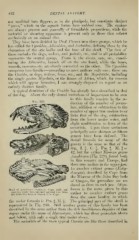Page 442 - My FlipBook
P. 442
452 DENTAL ANATOMY.
not modified into flippers, as in the pinnipeds, but constitute distinct
*' paws," M'hicli in the aquatic forms have webbed toes. The canines
are always present and generally of formidable proportions, while the
sectorial' or shearing ai)i)aratus is present only in those that subsist
exclusively on an animal diet.
They have been divided by Prof Flower into three groups, which he
has called the Ci/noidea, Ailuroidea, and Arctoidea, defining them by the
characters of the otic bullse and the base of the skull. The first of
these includes the dogs, wolves, and jackals, etc., and in all ])rol)ability
represents the central group. From it the civets, cats, etc., consti-
tuting the Ailuroidea, branch oli' on the one hand, while the bears,
weasels, raccoons, etc. are closely connected on the other. The Oynoidea
comprises two families—according to most authors only one ; these are
the Canidce, or dogs, wolves, foxes, etc., and the 3Ie(/alotid(c, including
the single genius MegulotiH, or the fennec of Africa, which, for reasons
which will a])pear hereafter, I am strongly disposed to regard as an
entirely distinct family.
A typical dentition of the Canidcc has already been described in that
of the dog. About the only dental variations of importance to be seen
in this family consists in the re-
Fig. 229.
duction of the number of premo-
lars, addition or subtraction to the
number of upper true molars to or
fniiu that of the dog, subtraction
from the lower molar series, and
slight modification in form of the
sectorials. Upon these variations
principally some thirteen or fifteen
genera have been defined. The
dental formula for many of the
genera is the same as that of the
dog, I. C.j, Pm.f, M.| =
I,
42, but the extinct Miocene genus
Amphicyon (Fig. 229), found both
in this country and Europe, had
three true molars in the ujiper jaw.
In another extinct genus [Enhy-
drocyo)i), described by Cope from
the iSIiocene of the John Day beds
of Oregon, the premolars are re-
duced to three in each jaw. Olif/o-
bumts is the name given by this
Skull of AwjiliKii-ii (ii\i ir/niis ( (i])e
supi'iior molar lost, one-half natural size, from author to another extinct genus
the John Day beds of ()ret;on (after Cope).
from the same locality, in which
the molar fin'nuda is Pm. |, M. ^. The principal part of the skull is
represented in Fis;. 280 Still another genus of this family has been
described by the same author from the rich fossiliferous deposits of that
region under the name of Hycenocyon, which has three premolars above
and below, with only a single true molar above.
The sectorials of the more typical Canidw are like those described in


